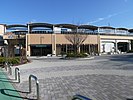Railway line in Nagoya, Japan
| Aonami Line | |
|---|---|
 A 1000 series EMU A 1000 series EMU | |
| Overview | |
| Native name | あおなみ線 |
| Owner | Nagoya Rinkai Rapid Transit |
| Locale | Nagoya |
| Termini | |
| Stations | 11 |
| Service | |
| Type | Commuter rail |
| Depot(s) | Shionagi (between Inaei and Noseki Stations) |
| Rolling stock | 1000 series |
| Daily ridership | 43,888 (2018) |
| History | |
| Opened | 1 June 1950 (as Nishi-Nagoyakō Line) 6 October 2004 (as Aonami Line) |
| Technical | |
| Line length | 15.2 km (9.4 mi) |
| Track gauge | 1,067 mm (3 ft 6 in) |
| Minimum radius | 191 m |
| Electrification | 1,500 V DC, overhead catenary |
| Operating speed | 110 km/h (70 mph) |
The Aonami Line (あおなみ線, Aonami-sen) is a third-sector commuter railway line in the city of Nagoya operated by the Nagoya Rinkai Rapid Transit (名古屋臨海高速鉄道, Nagoya Rinkai Kōsoku Tetsudō). Officially called the Nishi-Nagoyakō Line (西名古屋港線, Nishi-Nagoyakō-sen, West Nagoya Port Line), it connects Nagoya Station with Kinjō-futō Station.
The line was formerly a freight branch line of Tokaido Main Line, converted for passenger usage in October 2004. It is still operated as a freight line by Japan Freight Railway Company between Nagoya and Nagoya Freight Terminal; thus, the section between Nagoya and Arako Station is used for both passenger and freight traffic. Since its opening in 2017, the Aonami Line is used as the main rapid transit access to Legoland Japan Resort and SCMaglev and Railway Park, both located nearby the terminus.
The line's name is a combination of the company's color ao ("blue"), na for Nagoya, and mi for Minato ward. As two words, ao nami can also be read as "blue waves."
Stations
There are two services on the line: Local and Non-stop. Non-stop services only stop at Nagoya and Kinjō-futō.
Rolling stock
Services on the line are operated by a fleet of eight four-car 1000 series electric multiple unit (EMU) trains. All trains are operated as conductorless "one man cars".
History

The Nishi-Nagoyakō Line opened on 1 June 1950 as a freight branch of the Tokaido Main Line between Sasashima Freight Terminal (笹島貨物) and Nishi-Nagoyakō (西名古屋港) operated by Japanese National Railways (JNR). Nagoya Freight Terminal opened on 1 October 1980 as part of the initial construction of the Nanpō Freight Line, and with the closure of Sasashima Freight Terminal on 1 November 1986, Nagoya Freight Terminal became the starting point of the line. With the privatization and division of JNR on 1 April 1987, the line was transferred to Central Japan Railway Company (JR Central) as a "Class 1 railway operator" and JR Freight as a "Class 2 railway operator".
Plans to operate passenger services on the line were formalized in the 1990s, and Nagoya Rinkai Rapid Transit company was established in 1997 as a third-sector company funded by the city of Nagoya. The passenger Aonami Line utilized approximately 12 km of existing freight line with a newly constructed approximately 4 km extension to Kinjō-futō Station. Construction started in 2000, with improvement to the line and new stations added between Nagoya and Nakajima stations. The tracks between Nakajima and Kinjō-futō stations were raised to remove level crossings and alleviate road congestion. Construction cost around 93 billion yen. The line opened on 6 October 2004, and at the same time, the section of track between Nagoya Station and Nagoya Freight Terminal was closed.
Despite serving attractions such as the Nagoya International Exhibition Hall and Nagoya Racecourse (moved to Yatomi in 2022), passenger ridership figures fell short of targets, and in July 2010, the operating company declared debts of approximately 46 billion yen, applying for alternative dispute resolution (ADR) to avoid bankruptcy.
A special "SL Aonami-go" steam train service operated on the Aonami Line on 16 and 17 February 2013, using JNR Class C56 locomotive number 160 as well as three 12 series passenger coaches.
On 27 March 2017, a special Legoland-themed train started operating on the line to commemorate the opening of Legoland Japan, located near Kinjō-futō Station.
See also
References
- ^ "令和元年版名古屋市統計年鑑 11.運輸・通信 11-6.西名古屋港線(あおなみ線)各駅の乗車人員" (in Japanese). Retrieved 22 August 2020.
- ^ Terada, Hirokazu (19 January 2013). データブック日本の私鉄 [Databook: Japan's Private Railways]. Japan: Neko Publishing. p. 114. ISBN 978-4-7770-1336-4.
- ^ "よくある質問". あおなみ線 (in Japanese). Retrieved 20 May 2024.
- 私鉄車両編成表 2013 [Private Railway Rolling Stock Formations - 2013]. Japan: Kotsu Shimbunsha. 30 July 2013. p. 102. ISBN 978-4-330-39313-1.
- "Overview of Aonami Line" (PDF).
- "「あおなみ線」来月6日10周年、近藤社長に聞く、レゴランド開業で集客策、IC乗車券の全国対応も。". Nikkei Messe.
- "LEGOLAND train begins service on Nagoya's Aonami line". Japan Today. 29 March 2017. Retrieved 6 April 2017.
External links
- Official website (in English)
| Stations of the Aonami Line | |
|---|---|
| Transit in Greater Nagoya (Chūkyō) | |
|---|---|
| Shinkansen | |
| Minor private railways | |
| Third-sector railways | |
| |
| Terminals |
|
| Miscellaneous |
|










